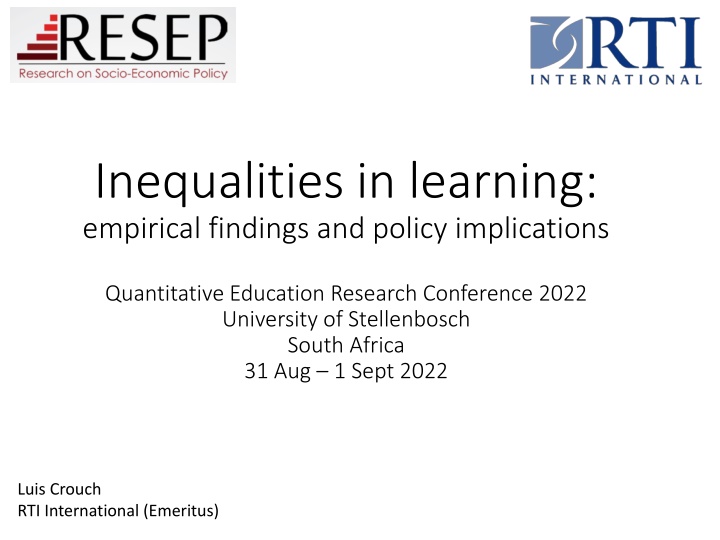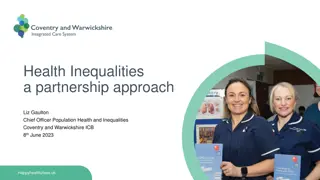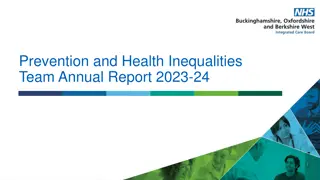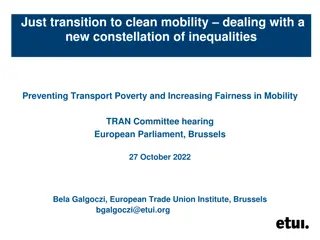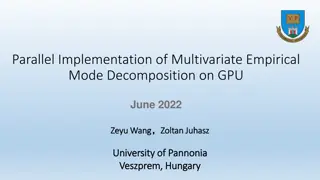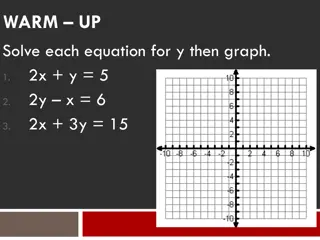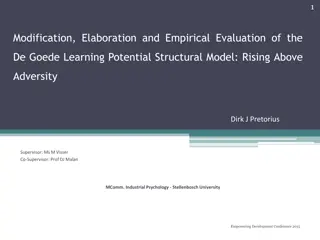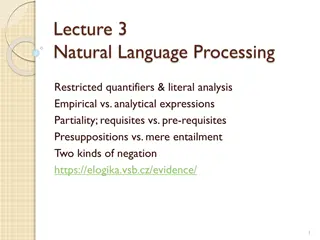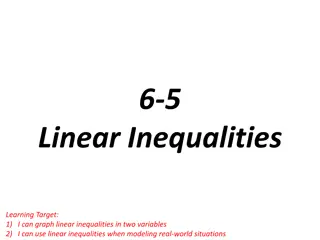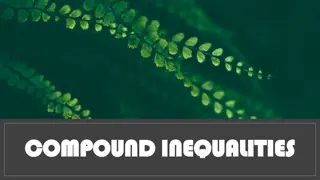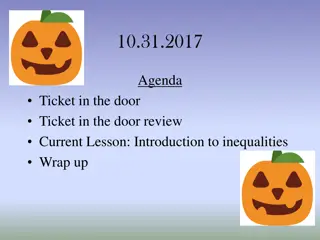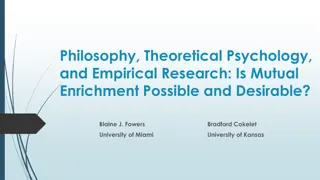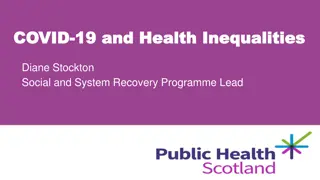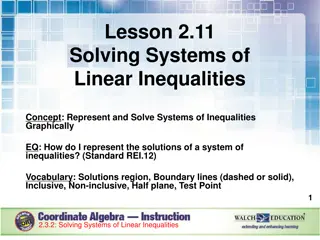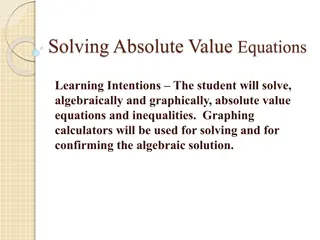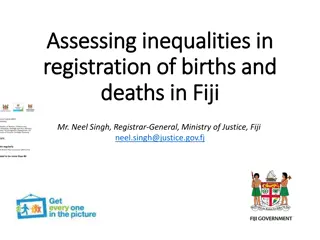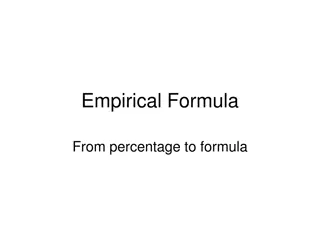Inequalities in Learning: Empirical Findings and Policy Implications
This study delves into inequalities in learning, presenting empirical findings and discussing their policy implications. It covers the impact of purposeful learning projects, natural variations, lessons learned, and management implications. The content emphasizes the importance of addressing learning poverty and achieving high average learning levels. It also explores the distinctions between equality and equity in education and their relationship to societal development.
Download Presentation

Please find below an Image/Link to download the presentation.
The content on the website is provided AS IS for your information and personal use only. It may not be sold, licensed, or shared on other websites without obtaining consent from the author.If you encounter any issues during the download, it is possible that the publisher has removed the file from their server.
You are allowed to download the files provided on this website for personal or commercial use, subject to the condition that they are used lawfully. All files are the property of their respective owners.
The content on the website is provided AS IS for your information and personal use only. It may not be sold, licensed, or shared on other websites without obtaining consent from the author.
E N D
Presentation Transcript
Inequalities in learning: empirical findings and policy implications Quantitative Education Research Conference 2022 University of Stellenbosch South Africa 31 Aug 1 Sept 2022 Luis Crouch RTI International (Emeritus)
Outline Why should we care? Findings Natural variations and patterns Effects of purposeful learning projects Lessons and Policy/Management Implications What we seem to know What we don t know Possible implications
Why care? Instrumental logic High average learning (not just access) economic and social development, nation-building Countries most successful at average seem to: Have lower inequality Have lower learning poverty Lower educational inequality lower social inequality, maybe faster growth A pure rights or ethics, justice A Rawlsian perspective Hard to use in public policy discourse
Some useful distinctions Equality A purely mathematical construct, reasonably measurable In education can be of inputs, of access, of learning, and, eventually, job satisfaction, happiness, etc. Perfect equality is not inherently desirable, but Equity is Approx the same as justice But not very measurable, has to rely on interpersonal subjectivity Higher inequality may be more equitable E.g., more inputs for poorer Perfect equality may be inequitable A society that provides everyone with a lower level than is possible, but equally for everyone, is both unjust because it is inefficient Low equity unnecessary inequality Learning poverty = % of pop below minimum learning level I will mostly be referring to equality of learning results and learning poverty here Noting that in most countries, generally more equality more equity
Why care? Instrumental We want high averages, but High learning averages and learning inequality are inversely correlated High learning levels and learning poverty are even more inversely correlated Inequality and learning poverty are close but not quite the same PIRLS 2016 0.15 (Range 75th to 25th / Med.) 3X bigger relative variation (inequality) in SA 0.18 0.25 0.12 3 X as much inequality to be explained in SA Finland Coeff of V SA Finland SA Finland Coeff of V R^2 R^2 ( 1 - R^2) * CV 0.45 0.34 SA ( 1 - R^2) * CV That's R^2 with "best" reg: home factors, resources at school, the usual suspects
Instrumentally Equality and low poverty both highly corr with excellence Inequality and Median Achievement Learning Poverty and Median Achievement 650 650 PIRLS 2016 Median Achievement 600 600 PIRLS 2016 Median Achievement 550 550 500 500 R = 0.8805 R = 0.9478 450 450 400 400 350 350 300 300 0.2 0.4 0.6 0.8 1 1.2 0 10 20 30 40 50 60 70 80 Inequality Percent below Minimum If you face the two against each other in explaining median achievement, then learning poverty dominates the effect of inequality by a lot
Another way to look at it Range countries by median achievement and look at the diff between 5th and 95th percentiles. At low learning levels the diff is 1.2 the median. At high learning levels the diff is only 0.4 times the median. Median, 5th, 95th percrentiles 800 700 600 500 400 220 points diff = 0.4 times the median 300 200 400 points diff = 1.2 times the median 100 0 1 3 5 7 9 11 13 15 17 19 21 23 25 27 29 31 33 35 37 39 41 43 45 47 49 51 53 55 57 59 61
Is any of this causal? I do not think there is an econometric way to identify One has to study history and policy (shudder) If one looks at policies of countries such as S Korea (1945 and on) and Japan (1870 and on), the intent is clear: Extreme focus on equity as a form of class consciousness (Japan against the samurai class) and anti-colonial resistance (S Korea against the West and very much against Japan, Japan against the West) Specific policies of equalization of inputs Planned expansion to higher levels *only* when primary ed was 100% for everyone and of high quality (high expectations, high standards, and good inputs) Both for equality reasons but also efficiency: expand only as the society requires and can afford I think it is pretty causal
Bottom 20% of pop has only 3% of the income Illustrate Gini, Lorenz Next 20% (cum. 40%) of pop has only 7% of the income (cum 10%) And so on Next 20% (cum 60%) has about 10% (cum 20%) of the income The line describing the actual situation is the real distribution: the Lorenz curve The diagonal line is the line of equality Whole blue area relative to the area under the line of equality hints at a measure of inequality, the Gini coeff. (Not tech. quite correct, don t worry)
Illustrate Gini, Lorenz Shows connection between inequality and some sense of absolute learning poverty as used in this PPT: here the bottom 40% score zero on EGRA, and hence have 0% of the cognitive achievement
Historical look By looking at successive cohorts you can see education inequality over time India had as much inequality in 2000 (red line, 15-24) as Korea did in 1960 (blue line 55+) This is a pretty good measure of how seriously S Korea takes these things.
Inequality impacts of foundational learning interventions Foundational learning projects have been evaluated for mean effect. Often good, effect sizes > 0.25 or even > 0.5 Systematic reviews: structured pedagogy and teaching at the right level are tops among the best interventions available, based on effect sizes Some interventions evaluated for heterogeneity by gender or wealth quintile But there has been little research into how these interventions affect pure inequality, as opposed to attribute-related (e.g., gender-related or wealth- related) What if these interventions address pure inequality even if they were not intended to do so? And if they do, why/how?
Why focus on foundational learning? Interventions have been well-evaluated, lots of data Because of good average effects, it makes sense to look further. If average effects were minor, not much point in seeing what (if any) other desirable results they generate Some of the measurement tools lend themselves to metrics that are easier to interpret Oral reading fluency is pretty easy to measure and interpret without IRT, more akin to and income metric % of kids reading with 0 fluency is akin to absolute poverty and the WB s learning poverty: also easy to interpret
Features of the data and interv. Foundational reading (grades 1, 2, 3) Some version of structured pedagogy Use Oral Reading Fluency sub-test of EGRA as key metric There are good justifications for this Test out various inequality and learning poverty measures: CoV, Gini, P90/P10, and % reading at 0 fluency Some projects more successful at raising the mean than others
Basic results p90/ p10 . . . 25.3 . . . 14.3 . . . . . . p75/ p25 . 16.7 . 2.7 . . . 2.3 . . . . . . Country Language Grade Phase Mean Gini CV % zero Base End Base End Base End Base End Base End Base End Base End 6.5 29.1 25.1 54.5 4.4 18.9 17.8 32.6 3.0 5.7 0.2 2.1 6.2 10.4 0.799 0.522 0.546 0.363 0.809 0.499 0.522 0.338 0.874 0.835 0.988 0.905 0.788 0.672 2.0 1.0 1.0 0.6 2.0 0.9 0.9 0.6 2.8 2.2 9.0 2.9 1.8 1.3 62.4 21.6 25.8 8.5 68.9 25.8 30.7 8.9 72.8 67.3 97.7 86.3 65.4 48.5 1 English 2 Kenya PRIMR 1 Kiswahili 2 English 2 Uganda 1 Luganda 2 P90/P10 and even P75/P25 are pretty useless because of all the zeroes The three internal r average to 0.84: there is a latent construct of reading inequality But the r is not so high that they measure exactly the same thing The % zero is a concept of poverty, the others of inequality, but the % zero is a much easier thing to manage to The visual representation of the Gini, with the Lorenz curve, includes the % at zero
Some interpretations, as examples only Subst: Home languages in Uganda differ hugely in their internal inequality. This is not necessarily due to differential poverty Method: Notice how Lorenz curve nicely summarizes the % at 0 (hor. axis intercept) and the rest of the inequality
Learn ineq not highly corr w poverty I am not enough of a sociologist / linguist to understand this but it probably has more to do with how old and widespread orthographies in these languages are, or home language methods, than with material poverty
Some interesting (??) insights That there is more inequality among the poor These interventions can help the poor more though they do not target (internal to the interv.) by poverty Improvements in the mean are highest in Quartile 1, and within-Quartile 1 inequality is reduced the most Kenya PRIMR Grade 2 Gini % at zero Oral Reading fluency SES Quart BL EL EL-BL BL EL EL-BL BL EL EL-BL 1 0.51 0.45 -0.06 0.19 0.15 -0.05 30.5 45.3 14.8 2 0.4 0.39 -0.01 0.11 0.1 -0.01 45.7 54.2 8.5 3 0.34 0.31 -0.03 0.06 0.06 0.01 55 63 8 4 0.32 0.28 -0.05 0.03 0.02 -0.01 63.1 66.6 3.5 All 0.4 0.35 -0.05 0.09 0.08 -0.02 49.4 58.1 8.7
Interpretations, conclusions Disaggregate, disaggregate, disaggregate Inequality as shown here but also inequality in response Most of the average impact is coming from to 1/3 of the schools! Why? Language? Maybe. Lower base, hence easier? No. Individual coach effect? Maybe? Do only some teachers absorb deeply and the rest just pretend but pedagogy is still quite bad despite the coaching? Source: King, S. Presentation at RISE 2022 Conference, Oxford, UK
Interpretations, conclusions Maybe silly ( not rocket science ) but: Interventions that really, really focus on the foundational skills, with intensity and fidelity, end up helping the poor within the interventions even if there was no targeting-within Self-targeting? But how much more could be achieved if there was targeting based on SES or initial situation? But should there be? Or does the help provided by high intensity and fidelity enough? We see improvements but kids are by no means fluent, not is inequality reduced to the levels of good systems, by a long shot There is a lot we do not understand (previous slide) We have a lot of work to do
